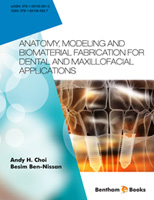Valuable insights into the modeling, application, and production of bioactive materials
This book provides comprehensive coverage on computational modeling and the types of bioceramics and surface modifications currently used in dentistry.
Anatomy, Modeling and Biomaterial Fabrication for Dental and Maxillofacial Applications provides readers with information about dental implants and biomaterial fabrication for maxillofacial procedures and dental bone / tissue repair. It will also provide valuable insights into the application and production of bioactive materials for any researchers and students in materials science and biomedical engineering.
Bioceramics prior to the 1970s were utilized as implants to perform singular and biologically inert roles. The limitations with these manufactured materials as tissue substitutes were emphasized with the growing realization that tissues and cells of the human body function other different metabolic and regulatory roles. Acquiring a deeper insight into the manufacturing process in addition to the properties of bioceramics (physical, mechanical, and biological) currently used as implants and as bone replacement materials could significantly contribute to the design of new-generation prostheses and implantable devices as well as post-operative patient management policies. The advantages of utilizing advanced ceramic materials in dental and oral and maxillofacial applications have generally been welcomed, particularly their strength and biocompatibility. Enhancements in the fabrication process can produce ceramic materials with higher densities and smaller grain structures which are essential for their utilizations in dentistry and maxillofacial surgery.
The relationship between biological responses and surface properties of materials is one of the main issues in biomedical materials research. Currently, one of the key drawbacks of synthetic implants is their failure to adapt to the local tissue environment. Surface modification using nanocoatings and nanocomposite coatings has become a vital tool in the research aimed at gaining an insight into how the chemical and surface properties of the materials used will influence its interaction with the biological system. As a deeper understanding is achieved, it is anticipated that surface modifications aimed at controlling tissue response will generate new opportunities for the research and development of new and improved dental and maxillofacial implants and prostheses in a more rapid and systemic manner.
Undoubtedly, the complications most frequently associated with the use of implantable medical devices such as dental implants are bacterial infections. The search is ongoing to find a more effective and less costly means of delivering antibiotics to fight against bacterial infections without the complications associated with long-term intravenous access and the toxicity of systemic antibiotics. For any drug carriers that utilize nanocoatings and nanocomposite coatings, the appropriate rates of dissolution as well as their control within the human body is the primary concern. A number of studies were carried out to investigate ways in which long-term release or long circulating time carriers can be developed. Among these, the surface modification of nanocoatings and nanocomposite coatings with a variety of polymeric macromolecules or nonionic surfactant were found to be the most effective. Nevertheless, appropriate and efficient modifications of the nanoparticles within multifunctional nanocoatings are a necessity for the future for slow drug delivery devices and systems.
New generations of medical implants and devices with these functionalized surfaces will require nanoscale surface properties measuring techniques that can be used to describe both living tissues and inorganic materials as well as the interfacial reactions between implant and bone tissue for future modelling and implant and prosthesis design. The use of theoretical modeling approaches such as finite element analysis (FEA) is becoming a necessity in the fields of medicine and dentistry. By examining the mechanics of a single cell using FEA, we could potentially accelerate discoveries in the fields of regenerative medicine, drug discovery, and mechanobiology.
About the Author
Anatomy, Modeling and Biomaterial Fabrication for Dental and Maxillofacial Applications is written by Andy H. Choi, Ph.D. in the Faculty of Science at the University of Technology Sydney, Australia. He is an early career researcher who received his doctorate on FEA to study the biomechanical behavior of ceramic and metallic dental implants inserted into the human mandible. After completing his doctorate, he expanded his research focus to biomaterials and nanocoatings, in particular, calcium phosphate-based nanomaterials for biomedical applications. In late 2010, he undertook post-doctoral training at the Faculty of Dentistry of the University of Hong Kong concentrating on the application of FEA in dentistry and the development of calcium phosphate nano-bioceramics.
Chapters in the book focus on the applications of mathematical and computerized modeling methodology in dentistry and oral and maxillofacial surgery, at both research and clinical levels. Furthermore, this book also covers the types of bioceramics and surface modifications currently used and their production methods and properties. It is an ideal reference for medical and dental students and professionals (dentists, oral and maxillofacial surgeons, orthopedic surgeons, prosthodontics) who are involved in implantology and tissue engineering.
Keywords: Alternative Medicine, Biomedical/Environmental/Chemical Engineering, Chemistry/Physics/Materials Sciences, Dentistry/Periodontal Disease, Health Care Systems/Services, Medicine/Health, Technology/Engineering/Computer Science

